“It stands quite alone as a standard of excellence among military pistols”
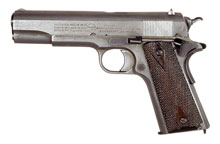 IN THE PASSING years since the adoption of the Browning/Colt Model of 1911, the development of military pistols has been influenced by three major factors: advances in firearms design, gradual changes in military requirements, and the introduction of new materials and manufacturing methods. All of the Colt's contemporaries have long since disappeared from the martial arsenals of the world, but the 1911 still retains its position as the standard service pistol of the United States. The only military handgun in history to compare with this record was Britain's 455 Webley revolver, which passed through 6 Marks and broached the transition from black to smokeless powder in its long and stormy career. However, even the great Webley has been far outstripped by the Browning/Colt, both in length of service and in actual battle use.
IN THE PASSING years since the adoption of the Browning/Colt Model of 1911, the development of military pistols has been influenced by three major factors: advances in firearms design, gradual changes in military requirements, and the introduction of new materials and manufacturing methods. All of the Colt's contemporaries have long since disappeared from the martial arsenals of the world, but the 1911 still retains its position as the standard service pistol of the United States. The only military handgun in history to compare with this record was Britain's 455 Webley revolver, which passed through 6 Marks and broached the transition from black to smokeless powder in its long and stormy career. However, even the great Webley has been far outstripped by the Browning/Colt, both in length of service and in actual battle use.
The reasons for the Colt automatic's longevity are various and complex. Unquestionably the basic excellence of the gun and of its unique cartridge have always been paramount, but many other contributory factors may also be cited, whose total leverage has proved irresistable.
A historically related series of events began in 1892, when the Double Action 38 New Army Revolver replaced the 45 Single Action Army, which had been standard issue since 1875. The new revolver appeared to hold great potential, since its swingout cylinder offered simultaneous ejection and fast reloading, its double-action mechanism increased the rate of fire, and the greatly reduced level of recoil made the gun pleasant to shoot. Whatever the good qualities of the revolver, however, the 38 Long Colt cartridge proved woefully inadequate in battle. This became evident during the close-quarter encounters of the 1899 Philippine Insurrection, where quantities of 45 Single Action Colts were hastily reissued to supply the stopping power that the newer handgun patently lacked.
In 1904, the Army's Ordnance Department assigned Col. (later Brigadier-General) John T. Thompson of Ordnance and Col. La Garde of the Medical Corps, to conduct an investigation into the hitherto shadowy subject of stopping power. The Thompson-La Garde Committee determined the nature of wounds and shock effect by the empiric method. Exhaustive shooting trials were conducted, initially with human cadavers, later with live steers at the Chicago stockyards. Several then-current revolvers and pistols were used for the tests, including the 7.65mm and 9mm Parabellum, and Colt automatic pistols in 38, 45, and 476 caliber, using various types of ammunition.
The Committee's findings were of great significance in several areas. Recommended as the most effective man-stopper was the 45 caliber, with a blunt nosed bullet of at least 230 grains and a minimum initial velocity of 800 feet per second. The 9mm Parabellum was found to be relatively ineffective as a man-stopping cartridge. It was noted that this small caliber, relatively high velocity bullet inflicted small, clean wounds that were easily healed. Frequently the body was completely penetrated without instantaneous damage, and apparent damage was occasionally delayed for hours. The tests proved conclusively that the often quoted muzzle energy figure (kinetic energy of the bullet, derived solely from its mass and velocity and expressed in ft. lbs.) has no direct bearing on the relative stopping power, since it does not consider the cross-sectional area of the bullet (frontal area) nor the factor of bullet shape. (Stopping power is also influenced by expanding bullets, but these have been outlawed for military use since the Second Hague Conference of 1907).
On receipt of the Thompson-La Garde report the Ordnance Department determined to adopt a new service pistol in accord with the Committee's recommendations. Manufacturers were invited to submit 45 caliber pistols for the lengthy series of comparison tests and field trials that were to proceed intermittently from 1906 to 1911.
Both Colt and Smith & Wesson presented 45 caliber revolvers for evaluation, but during these years the automatic pistol was coming into its own, and the military advantages of the new firearm type were so compelling that the revolvers had little chance of acceptance.
Colt's 45 automatic was designed by John Browning and was, from the very beginnings of its development, intended as a military pistol. Each element of its construction was chosen for that specific purpose, and all compromises were resolved in favor of military use. Nonetheless, as the pistol went through the Army's gruelling tests in competition with rival designs, weaknesses and inadequacies appeared within the prototypes, and changes were made as the trials went on. Since the tests were conducted in peacetime, the Army proceeded in leisurely fashion, insisting upon extremely high standards of reliability and strength. No inherent weakness remained in the final version of the big Colt, which passed the last 6000-round endurance test without a stoppage or broken part. The selection board adjudged the Colt as a clearly superior design and recommended its adoption; shortly thereafter, in early 1911, it became the standard service pistol. The true extent of the Colt's superiority has only become evident with the passage of time.
The 45 Government Automatic Cartridge was adopted simultaneously with the Colt pistol. This round, carrying a full-jacketed 233-gr. bullet, was developed at Frankford Arsenal from an original Browning design. Although considerably smaller in case capacity than the old 45 Colt revolver cartridge, the 45 Automatic was nearly as powerful, since it was designed for maximum efficiency with smokeless powder.
The new pistol/cartridge combination was used in a series of skirmishes along the Mexican border, and carried into Mexico during the punitive expedition against Pancho Villa's raiders, but the first large scale battle test of the arm followed America's entry into World War One, when U.S. troops arrived in the trenches of Belgium and France. Here, under actual field conditions, the 1911 established its reputation as a rugged, reliable handgun, and also as a dependable man-stopper, despite the rarity of documented enemy casualties that could be attributed to it. Most officers and NCOs were armed with the Colt, however, and no rumors of failure, either of arm or ammunition, ever surfaced.
Criticism of the 1911 did arise during the WW I period, and as a result, certain modifications were later undertaken at Springfield Armory to improve the pistol. These consisted of a widened front sight to better the sight picture; an enlarged spur on the grip safety to prevent pinching of the thumb web during recoil; a shorter trigger and finger cutouts in adjacent receiver areas, to accommodate soldiers with small hands and generally improve trigger control; and a curved mainspring housing, to benefit the pistol's pointing characteristics and afford a superior grip. In 1926 these changes were approved, and the modified pistol was accepted as the M1911-A1. All service pistols manufactured since that date have conformed to the Al specifications, and the older guns were gradually modified as they were returned to military arsenals. It should be noted that the improvements effected in the Al version were entirely external in nature; no mechanical changes have ever been made.
The 30-M1 Carbine, adopted upon the very eve of World War Two, was conceived as a replacement for the pistol in the hands of combat troops. In the event, this did not occur. Both weapons were manufactured in huge quantities and equally distributed to U.S. forces in all war zones. The relative value of each was not difficult to assess, since WW II was a long war, and the best documented in history. Combat reports and wound statistics proved the carbine an effective aggressive arm, while the pistol was revealed as a primarily psychological weapon. Times were changing; as shoulder arms became self-loading or fully automatic, the melee was becoming rare. Again, as in WW I, enemy casualties inflicted by the pistol were far flung and few, but its contribution to morale was strong.
The introduction of the German assault rifle during the course of WW II had broad repercussions in the postwar years. The Germans retained full power ammunition for the machinegun and the sniper rifle, but the basic weapon for the infantryman became a short, light, selective-fire rifle, firing a shortened 8mm cartridge of intermediate power and range. This single compromise weapon was intended to replace the full power rifle, the submachinegun, and, it was hoped, the pistol as well.
Russia embraced this concept without reservation, and the power and prestige of the U.S.S.R. carried the idea throughout the Communist World. The pistol could not be eliminated in any of these nations, but its role was downgraded and, in Russia itself, smaller, less powerful handguns were adopted.
With the usual exception of France, the powerful western nations reluctantly followed the lead of the United States in the acceptance of the 7.62 NATO cartridge. This round is a shortened, updated version of the 30-06 that differs only slightly in ballistics; a full power cartridge for rifle and machine gun. Our new infantry rifle became the M-14, and the carbine and pistol remained in service.
During the 1950s, the U.S. Army explored the possibility of a new handgun. Germany's P-38 seemed to hold th? answers to many of the complaints that had been leveled at the 1911 over the years; that it was too bulky and heavy, too powerful, too slow to get into action. In addition, the 9mm Parabellum cartridge had already become the universal choice of the other NATO countries for pistol and submachinegun use. Therefore, a list of requisites was established for a handgun of similar type, including a limitation in bore size of 30 to 35 caliber. Upon Army invitation, several strictly commercial designs were submitted for evaluation, as well as the T3 pistol, developed by the High Standard Company under direct Army contract. A number of these submissions were double action designs, and most were chambered for the 9mm Parabellum. The situation seemed strikingly reminiscent of that which had been obtained in 1892; single versus double action, 45 vs 38 (i.e., 9mm) caliber. The guns and the ammunitions were actually a far cry from those which had figured in that elder challenge, but the findings of the Thompson/La Garde Committee had never been discredited, although they appeared about to be ignored. However, trials were still in process when the decision was announced to retain the 1911, and the pistol testing was abruptly terminated. The reason for this decision has never been publicly revealed, and the preliminary findings of the tests themselves are still classified.
Certainly, a pertinent circumstance was the fact that the nation's armories retained an enormous stock of 1911 pistols produced during the WW II period, even beyond those at present in service in Korea and throughout the world. To replace these existing and battle-proven pistols with a handgun of new design would have required a major expenditure of funds, and this in face of a marked de-emphasis on the role of the pistol as a military arm.
Existing WW II stocks of M3-A1 submachineguns may also have clouded the issue, but only marginally. While these were also chambered for the 45 pistol cartridge, their design permitted conversion to 9mm Parabellum, and their number was not particularly large. Use of submachineguns by U.S. forces had been extensive only among paratroop units, and their future utilization was uncertain.
Naturally, the design of the 1911 and its 45 caliber cartridge were prime factors in the question of replacement. Gun and cartridge were inseparable, since a caliber change would almost certainly have resulted in a new pistol. The 45 U.S. automatic pistol round had been the center of controversy ever since its introduction. The heavy weight of its bullet creates an inordinate amount of recoil, and this characteristic has always caused unsettlement and even fear in military recruits undergoing their ordinarily rather superficial training with the 1911 pistol. The girth of the cartridge also reduces the magazine capacity below that of comparable 9mm pistols, and practically eliminates the possibility of staggered loading that the smaller caliber allows. The superior penetration of the 9mm Parabellum has often been cited as cause for change, since the 45 comes into difficulties against obstructions which the Parabellum pierces with ease. Penetration is of advantage to the submachine gun, an arm of offense, but with the exception of military police duty, the pistol had not been employed as an aggressive weapon since WW I. The role of the pistol had declined to one of a purely defensive arm, whose function consisted of stopping the advance of a determined opponent at close quarters. Stopping power and reasonable accuracy are the primary requirements of a weapon of defense, and these qualities the 45 possessed in full measure. A good man-stopper inflicts instant and massive bodily damage sufficient to break off an attack (not necessarily to kill), and the 45 will almost always achieve this result with a solid hit anywhere in the torso. No current military cartridge came near the 45 in this respect, certainly not the Parabellum.
The 1911 pistol itself was and is much too good to discard unless a prospective replacement could offer irresistible improvements. No pistol has ever surpassed the Colt for utter reliability. It has operated under the most extreme conditions of nature and endured the roughest treatment without failure, and has digested ammunitions of greatly varying chamber pressure without trouble. Any modern military pistol must be capable of field stripping without tools, but the 1911 goes much farther than this. It can be completely disassembled without the use of any tool, excepting only the grips, whose removal is never required. These are attached by four screws and bushings, the only screwed parts used in the gun. Breakage or loss of either or both grips has no effect on the gun's operation, and does not permit the escape of any other part, since all pins are mechanically retained within the pistol independently of the grips. This is an important feature; many of today's military pistols would be put out of action by grip failure.
The pistol's controls are intelligently located for convenience of operation. The hammer is easily thumb cocked, and its contour affords an excellent gripping surface. The safety lies directly above the thumb and operates with great ease. The pushbutton magazine release allows disengagement and ejection of the magazine using only the shooting hand, making this pistol one of the fastest of all automatics to reload. The slide stop works efficiently to signal an empty gun and hasten reloading, and it also permits locking the slide open manually at any time. The Colt's balance is good, and the gun handles well. The weight of the piece and its long sighting radius contribute to steady holding and accurate fire. The presence of the grip safety requires the use of both hands to lower the hammer from full cock. Since manual decocking is the single most dangerous operation necessary to the employment of an automatic pistol, the added control afforded by the mandatory second hand raises the level of safety proportionately.
As a mechanism, the 1911 abounds in excellent features. Its tilting barrel lock remains one of the strongest and simplest of locking systems, and its dual barrel lugs both contact recesses in the top of the slide, dispersing recoil forces over a large surface area. The tilting barrel also brings its breech into close proximity with the incoming round from the magazine, and this, plus the barrel tang, affords almost flawless feeding. It is true that a cam system such as Browning used in his later High Power pistol is slightly stronger and more efficient, but this superiority is in degree only; it certainly does not obsolete the swinging link of the 1911.
There is no finer extractor in any pistol. It is located entirely within the slide, fully protected against injury or the ingress of foreign matter. Since it does not pivot on a pin and acts as its own spring, it cannot become frozen by rust or hardened lubricant. The design of the feed mechanism is such that the rims of incoming rounds are forced upward behind the extractor, rather than requiring the extractor to snap over them, prolonging the life of the part. However, the extractor is sufficiently flexible to jump the rim of a hand-loaded round as the slide is slam closed upon it. Damage or loss of the magazine does not completely disable the big Colt, since its slide stop, large ejection port, and lack of a magazine disconnector allow handloading and firing in the total absence of the magazine.
The firing pin is an inertia type, affording safe carry with the hammer fully forward over a chambered round. Its long, tapered tip is highly resistant to breakage, while its symmetrical design allows the pin to turn freely, distributing wear. Dry firing is not injurious to the firing pin, because its forward movement in dry fire is arrested by the full compression of its spring, not by a retaining pin.
The firing-pin stop is also a fine feature of the 1911, locking the extractor as well as the firing pin, and affording easy disassembly of both parts.
Some criticism has been directed at the Colt's sliding, stirrup type trigger, because of its vertical play. This play is detrimental only in match shooting; the fact that the trigger does not pivot on a pin is actually of advantage to a military pistol. Neither rust nor any accumulation of debris is likely to affect the trigger's movement, and its operation cannot sweep mud or dirt into the receiver. The trigger and its bar are incorporated into one simple part, the trigger bar being entirely enclosed within the receiver. No other trigger/trigger bar system is simpler or more foolproof.
The safety mechanisms of the 1911 are also very good. Separate surfaces of the manual safety lock the hammer, the sear, and the slide.
The disconnector is completely enclosed by the receiver and operates within a rounded notch on the underside of the slide to prevent automatic fire and discharge with an unlocked slide. Should the gun be assembled without the disconnector, it cannot be fired.
The hammer's safety notch interrupts hammer fall in any circumstance that does not originate from trigger release. The sear enters this notch if the hammer slips in thumb cocking, or the slide moves forward after partial withdrawal, either manually or through an accidental fall upon the muzzle. If the sear loses contact with the hammer's full-cock notch through a jar, the safety notch allows the hammer's recapture before it can complete its stroke. The hammer safety notch is not a half-cock position and should never be so employed, because a blow upon the hammer in this attitude could fracture the sear or hammer notch and discharge the gun.
The grip safety blocks movement of the trigger unless the pistol is held naturally in the hand. Its location at the rear of the grip allows the safety to function without conscious thought, and reduces the danger of accidental self-inflicted wounds.
The Colt's magazine floorplate is permanently attached, in contrast to several more recent designs, whose detachable magazine floorplates allow easy takedown and cleaning of the assembly. Actually, the Colt pattern is preferable from a military standpoint, since this magazine cannot become accidentally disassembled and parts lost, yet its follower and spring may be removed from the top.
The sights are simple, effective, and strong. That they are nonadjustable is advantageous, since their height is calculated for service ammunition at pre-determined range, and they are factory set for windage zero. These sights have no small parts to loosen or break, and they cannot be tinkered out of adjustment. Their very low profile and rounded contours easily clear holster surfaces. Both sights may be replaced in case of damage, or target sights substituted for match shooting.
The 1911 has no really bad features, but it is less than ideal in several areas. The gun is large and heavy in weight, both factors owing to the cartridge it fires. Any reduction in weight would increase the difficulties of recruits in mastering the arm.
The grip safety was incorporated into Browning's prototype 45 at Army request, while the pistol was undergoing its pre-adoption trials. At this time, pistols were carried fully armed in the advance by infantry officers and non-coms, and employed in like manner by mounted cavalry troops. Compared to a shoulder arm, the pistol is difficult to control in a stumble or fall; its small size allows it to turn in the hand and endanger its bearer. An automatic safety reduces such risks, since it tends to engage as the wrist is twisted into an unnatural position. However, the new defensive role of the service pistol largely invalidates this consideration, and the grip safety is at present of small practical value in a military pistol having both an external hammer and a positive manual safety. The Colt's automatic safety causes few problems in its operation, but the safety's inclusion in the design requires a goodly number of additional parts, expensive machining operations, and an additional receiver opening, affording entry to water and dust.
A left-handed shooter encounters handling difficulties with the manual safety, but this is unfortunately true of almost all military automatics.
The external location of the safety plunger-tube exposes the safety and slide-stop plungers to water and dirt. The malfunction of either plunger would not put the gun out of action and they are easily serviced, but the arrangement is not ideal. Also, the tube is riveted to the receiver, and any looseness that should develop in these rivets cannot be serviced in the field.
The slide stop does not extend sufficiently rearward to afford good leverage, nor an easy reach for the thumb.
Field stripping of the 1911 is not difficult, but it is rather slow, fairly complicated, and results in more loose parts than could be desired. It should be noted, however, that there is no hazard of kinking the recoil spring during this operation, and that the gun cannot be improperly assembled in a dangerous condition.
The 1911 is not as safe as others whose design affords a mechanical means of decocking the hammer, and is theoretically inferior to a double action pistol, which may be cocked and fired by the application of a long pull on the trigger.
In practice, double-action trigger mechanisms tend to be delicate and complicated. It is doubtful if any such system offers the complete inter-changeability of parts enjoyed by the 1911 Colt, and none can match its reliability of function.
For reasons of safety, army regulations require that the Colt pistol be carried with its chamber empty in non-combat areas. Under such restrictions, there is no advantage to a double action pistol, since either type requires manual cycling of the slide before discharge is possible. In combat zones, the Colt is carried loaded, either with safety off and hammer fully down, or with hammer cocked and safety engaged. The first condition requires thumb cocking of the hammer before the gun can be fired, and is slower than the long trigger pull of a double-action pistol. In the second condition only thumb release of the safety is necessary; this operation may be performed and the gun discharged in about the time required to fire a double action design.
An often stated advantage of the double action automatic is its ability to quickly deliver a second blow to a reluctant primer. This may be a valid argument, but it seems equally likely that a soldier would prefer to manually reload the piece immediately upon a failure to fire.
On the whole, the supposed superiority of the double-action pistol is largely illusory. The idea has psychological value but, as a practical matter, an external hammer single-action automatic such as the 1911, having a positive safety properly located and contoured, is no less efficient.
In the years that have passed since the abortive pistol trials of the 1950s, significant changes have been made in U.S. infantry weapons. The venerable B.A.R. and the Browning 30 caliber machineguns have been withdrawn from service and quietly replaced by the excellent 7.62mm M60 General Purpose Machinegun, derived from the German FG-42 and MG-42 of WW II design. The jungle fighting in Vietnam called for a high rate of fire and a short, light weapon of intermediate power, a class of arm that fell midway between the M-14 and the M-2 Carbine. Caught in a pinch, the tail wagged the dog, and the services were forced to employ and eventually accept the previously rejected AR-15, with its untried gas system and unconventional design. Deficiencies arose in the field and manufacturing changes were made to counter them; the corrected version was adopted as the M16-A1, a good and serviceable weapon.
Withdrawal of American troops from Vietnam found the U.S. in the position of possessing large quantities of modern service rifles of both full and intermediate power, a luxury enjoyed by no other major nation on earth. The future employment of each has yet to be determined. What proved to be the ideal weapon for Vietnam may not suffice in more open country and under more conventional methods of warfare. In any case, the 30 Carbine and the 45 submachinegun would seem on the verge of obsolescence, and there is apparently no longer any possibility of adopting a 9mm submachinegun.
The nature of the war in Vietnam worked greatly to increase the status of the service pistol. Guerrilla activity in the cities meant that there were no safe areas in the country, and rearechelon personnel were often dependent on the pistol as a means of personal protection. Carrying it openly reduced chances of attack, and pistols were in great demand, whether authorized or not. Such lessons are not quickly forgotten.

Next Step: Get your FREE Printable Target Pack
Enhance your shooting precision with our 62 MOA Targets, perfect for rifles and handguns. Crafted in collaboration with Storm Tactical for accuracy and versatility.
Subscribe to the Gun Digest email newsletter and get your downloadable target pack sent straight to your inbox. Stay updated with the latest firearms info in the industry.

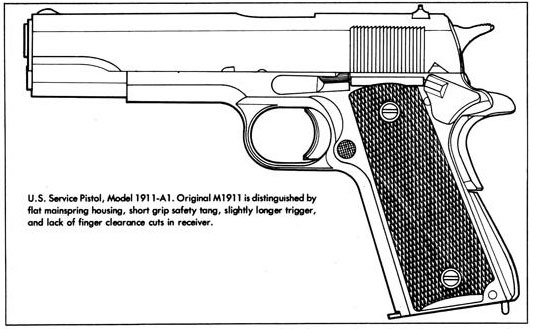
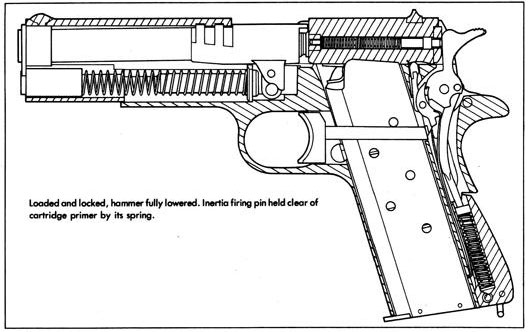
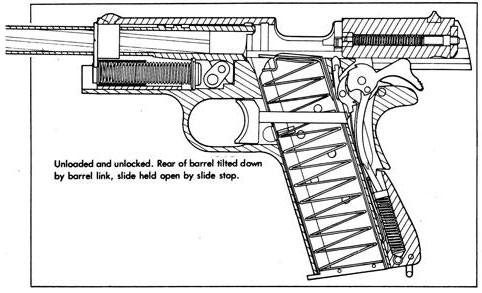
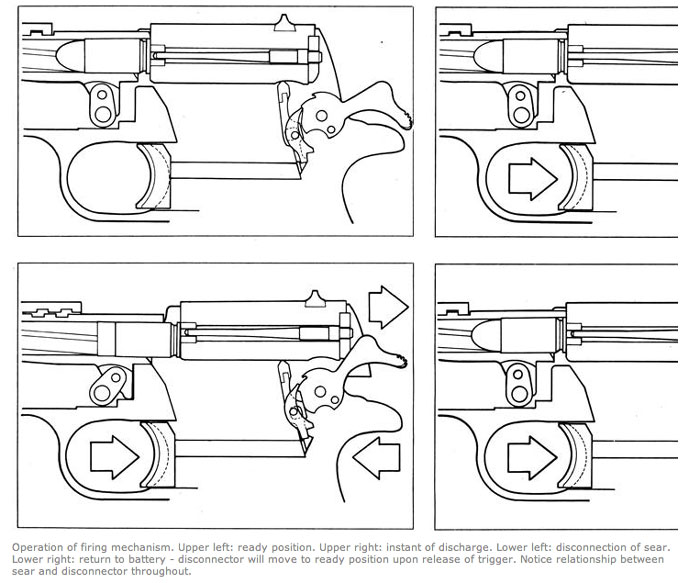



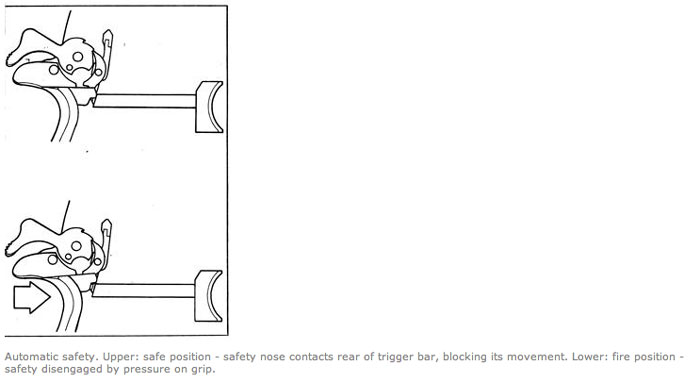
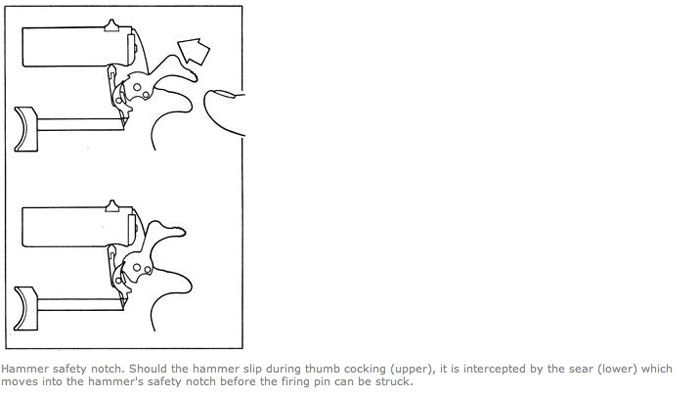
![Best Concealed Carry Guns In 2025 [Field Tested] Wilson Combat EDC X9S 1](https://gundigest.com/wp-content/uploads/Wilson-Combat-EDC-X9S-1-324x160.jpg)


![Best 9mm Carbine: Affordable PCCs [Tested] Ruger Carbine Shooting](https://gundigest.com/wp-content/uploads/Ruger-Carbine-Shooting-100x70.jpg)
![Best AR-15: Top Options Available Today [Field Tested] Harrington and Richardson PSA XM177E2 feature](https://gundigest.com/wp-content/uploads/Harrington-and-Richardson-PSA-XM177E2-feature-100x70.jpg)
